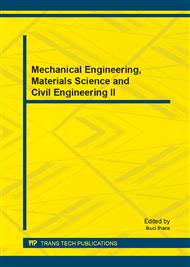p.827
p.832
p.838
p.842
p.847
p.857
p.862
p.866
p.871
Model Research of Concrete Reinforcement Corrosion Mechanism and Corrosion Rate under the Corrosion of Chloride Ion
Abstract:
This paper researches law of reinforcement corrosion under chloride environment based on method the simulated accelerated test. Test the self-corrosion current density and electrode potential quantitative index of concrete reinforcement under chloride environment and establish quantitative model of corrosion time and reinforcement corrosion quantity by means of advanced linear polarization method and electrochemical testing method. Corroded reinforcement weight loss ratio under chloride environment is detected in physical way, combined with reinforcement corrosion layer microstructure and composition characteristics detected by scanning electron microscope. Both of the above deeply reveals corrosion mechanism and corrosion characteristics of the reinforcement. Corrosion rate theoretical model and statistical model have been revised. The research results prove that reinforcement corrosion rate has increased by an average of 4-5 times under chloride environment, weight loss ratio has increased by 15% compared with that under no-chloride environment, and due to chlorine’s effect, partial and uneven corrosion rust layer appears on surface of the reinforcement, which will be the direct cause of inducing accelerating corrosion of reinforcement at the later stage.
Info:
Periodical:
Pages:
847-853
Citation:
Online since:
December 2013
Authors:
Price:
Сopyright:
© 2014 Trans Tech Publications Ltd. All Rights Reserved
Share:
Citation:


